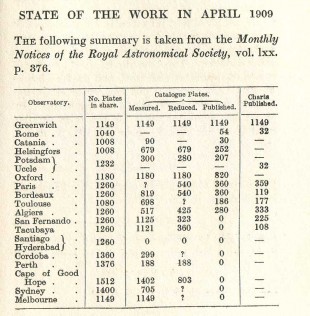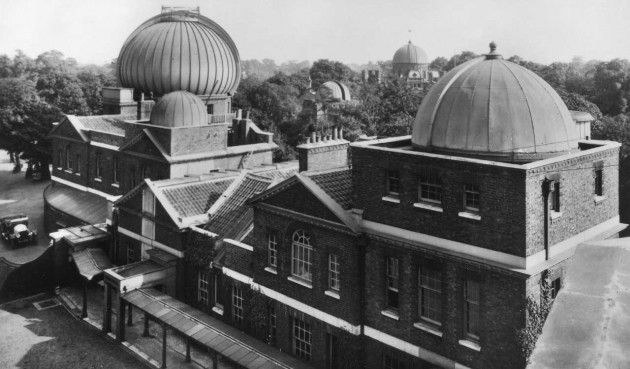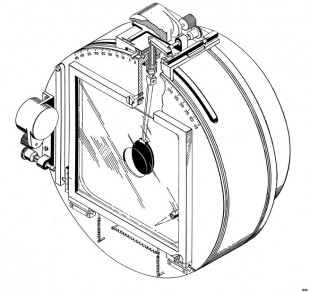…where east meets west
- Home
- Brief History
- The Greenwich Meridian
- Greenwich
(1675–1958) - Herstmonceux
(1948–1990) - Cambridge
(1990–1998) - Outstations (1822–1971)…
- – Chingford (1822–1924)
- – Deal
(1864–1927) - – Abinger
(1923–1957) - – Bristol & Bradford on Avon
(1939–1948) - – Bath
(1939–1949) - – Hartland
(1955–1967) - – Cape of Good Hope
(1959–1971)
- Administration…
- – Funding
- – Governance
- – Inventories
- – Pay
- – Regulations
- – Royal Warrants
- Contemporary Accounts
- People
- Publications
- Science
- Technology
- Telescopes
- Chronometers
- Clocks & Time
- Board of Longitude
- Libraries & Archives
- Visit
- Search
Telescope:13-inch Astrographic Refractor (1890)
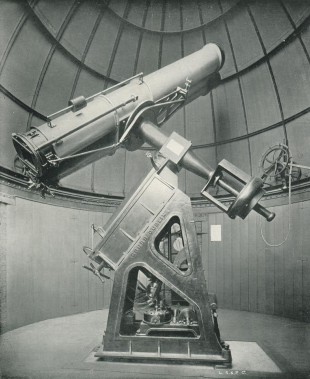
The Astrographic Refractor at Greenwich. Photo by the London Stereoscopic and Photographic Company. Known to have been published in Pearson's Magazine in 1896, this higher quality reproduction is taken from the Greenwich Astrographic Catalogue, Volume 1, (HMSO, 1904)
Made by Sir Howard Grubb of Dublin, it consisted of a 13-inch photographic refractor with a focal length of about 11 feet 3 inches (3.43m), firmly connected to a parallel 10-inch visual guiding telescope of the same focal length on a German Equatorial mount. It also had a 3-inch guiding telescope. The Astrographic Refractor contributed to both the Carte du Ciel and the Astrographic Catalogue. From 1905, the object glass began to be used in eclipse expeditions and from 1922, the whole telescope. Mothballed during the Second World War, the telescope was brought back into use at Greenwich in 1947/8. It stayed at Greenwich until 1956/7 when it was moved to Herstmonceux where it was re-erected in dome D in August 1957. It is still in dome D at Herstmonceux today.
Background to the Carte du Ciel
The Carte du Ceil has its origins in a photograph taken of the Great Comet of 1882 at the Cape Observatory, with a camera strapped onto an equatorial telescope. This was the first time a camera had been so mounted. The results were striking and attracted considerable attention, not so much for the image of the comet, but for the clarity of the surrounding field of stars. The French brothers Paul and Prosper Henry saw the potential for revolutionising the process of chart making and developed a photographic telescope with an objective of 13 inches aperture.
On the invitation of the French Academy of Sciences, an International Congress on Astronomical Photography, was held in Paris in April 1887 April. There, a scheme was approved for the photographic mapping of the heavens by the concerted action of a number of observatories in both hemispheres with a standardised telescope. According to this scheme two sets of photographs, each covering 2º by 2º (on a scale of about 1 mm to 1 minute of arc) were to be taken on 16-cm square photographic plates: one with long exposure (40 minutes) to form a photographic map of the whole sky (Astrographic Chart), and the other with short exposures (6m, 3m, and a supplementary exposure of 20s) from which a catalogue of reference stars was to be formed (the Astrographic Catalogue). Each set was to be taken in duplicate, the centres of one series being at the corners of the other. A reséau (grid) of cross-lines 5 mm apart was to be photographed on each plate to facilitate the determination of positions of stars.
The Astronomer Royal, William Christie attended the conference as a delegate of the Royal Society. At the meeting of the Board of Visitors on June 8, it was recommended that provision should be made to enable the Royal Observatory at Greenwich to take part and that steps should be immediately taken to provide the Royal Observatory with a suitable instrument. The sanction of the Treasury to the necessary outlay was obtained in 1888 August, and instructions were immediately given to Sir Howard Grubb, (with whom Christie had been in previously communication) to proceed at once with its construction. The instrument was delivered to Greenwich in May 1890. It was brought into working order and subjected to testing over the following year, with the production of plates for the Carte du Ceil beginning in December 1891.
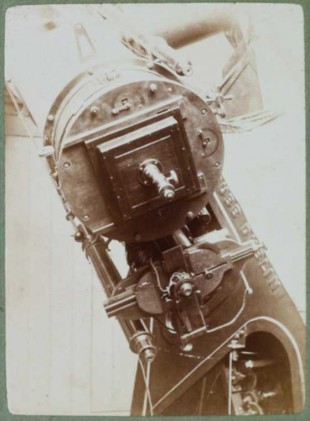
The plate carrier of the Astrographic Refractor, c.1900. Reproduced under the terms of a Creative Commons Attribution-NonCommercial (CC BY-NC) licence courtesy of whatsthatpicture (see below)
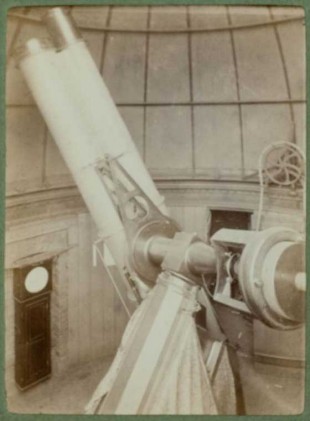
The Astrographic Refractor and the clock Dent 2017, c.1900. The clock was erected on 14 March 1891 (RGO7/29). Reproduced under the terms of a Creative Commons Attribution-NonCommercial (CC BY-NC) licence courtesy of whatsthatpicture (see below)
Participating Observatories
Twenty observatories from around the world participated, each of which was assigned a particular region of the sky to photograph. In total, over 22,000 (glass) photographic plates were produced in a programme that extended over several decades. The Carte du Ciel component was never completed, and for almost half a century the Astrographic Catalogue was largely ignored. It eventually came into its own following the publication of the Hipparcos Catalogue in 1997 which led to its re-examination.
Location of the telescope at Greenwich
At Greenwich, the telescope was housed in the 18-foot dome, which had been completed in June 1888, ostensibly to provide a permanent home for a 6-inch equatorial and photoheliograph from the Transit of Venus expedition of 1874. These were never in fact mounted and the dome stood empty until the mounting of the Astrographic Refractor in May 1890.
The dome was erected over Bradley’s old Quadrant Room and covered with papier-mâché on angle-iron. It had a sectorial shutter coming to a point at the zenith and opening 1/6th of the circumference at the horizon. This shutter was blown off in a gale of wind on 22 December 1894 (click here for image), and the instrument was out of use until 2 February 1895 while the shutter was being repaired, more secure fastenings being provided.
The instrument was at a height of 30 feet above the ground. The pier on which it rested, having been built on the top of the old Quadrant Pier, was firmly connected to the walls of the building below, but carefully isolated from the upper storey and observing floor.
The Astrographic Catalogue (Greenwich Section)
The Greenwich Section of the Astrographic Catalgue was published in six volumes between 1904 and 1932:
Astrographic Catalogue, Vol. I (Dec. +64º to +72º)
Astrographic Catalogue, Vol. II (Dec. +72º to +90º)
Astrographic Catalogue, Vol. III (R.A., Dec. and magnitude of Reference Stars)
Astrographic Catalogue, Vol. IV – Proper Motions and Photographic Magnitudes
Astrographic Catalogue, Vol. V – Proper Motions of Stars (Dec. +64º to +72º)
Astrographic Catalogue, Vol. VI – Proper Motions of Stars (Dec. +72º to +90º)
Click here for information on the volumes published by other observatories (over 200 volumes in total).
Eclipse Expeditions (1905–29)
| Year | Eclipse Location | Comment | |
| 1905 Aug 30 | Tunis | Object-glass (OG) only. 29 July 1905, left London on SS. Sumatra for Malta. 7 August, arrived Malta and transferred onto H.M.S.Suffolk. 18 August, taken to Sfax, arriving 19 August. Landed and carried to observing station the same day. 30 August, re-packed. 1 September, loaded onto H.M.S.Suffolk and takento Malta where it was transferred to a lighter where it remained until 8 September when it was loaded onto the S.S.Formosa. 17 September, arrived Gravesend. 19 September 1905, unloaded and returned to Observatory. OG was mounted in a wooden tube which was able to carry a square plate measuring 10 inches by 10 inches. A mahogany block was fixed to the OG section of the tube into which a steel ring 13½ inches diameter was let. The cell of the OG was attached to this ring by three adjsting screws. | |
| 1919 May 29 |
Sobral, Brazil | Object-glass only. |
|
| 1922 Sep 21 |
Christmas Island | July 1921, telescope dimounted at Greenwich for alteration and adjustment. 28 January 1922, shipped to Christmas Island with specially made stand. 23 March, docked at Christmas Island. By 1 May, mounted and adjusted. 21 September, photograph of telescope published in The Times (p14). 4 December, returned to Greenwich. 31 December 1922, remounted and ready to use. |
|
| 1929 May 9 | Siam (Thailand) | 12 February 1929, dispatched from Greenwich to Liverpool with stand used for the Chrismas Island eclipse. 16 February, shipped from Liverpool by S.S. Laomedon. |
Howse (1975) states that the telescope was also taken the Giggleswick in Yorkshire for the eclipse on 29 June 1927. The report submitted by Dyson for publication in the Monthly Notices of the Royal Astronomical Society, Vol. 87 suggests otherwise.
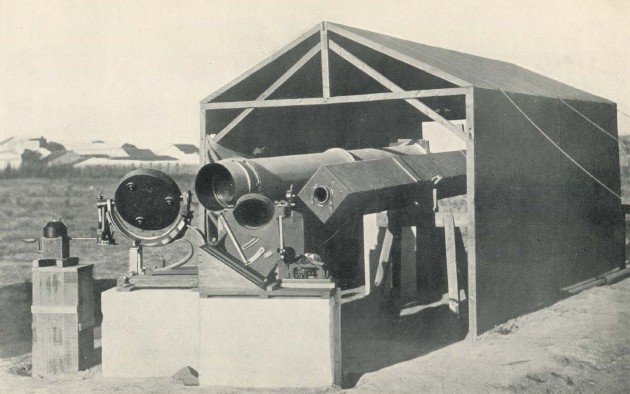
The Royal Observatory's observing site for the 1919 eclipse on the race-course at Sobral. The horizontal tubes in the shed are photographic telescopes. The 13-inch object glass from the Greenwich Astrographic Telescope is mounted in the (circular) tube on the left. Photo by Charles Davidson
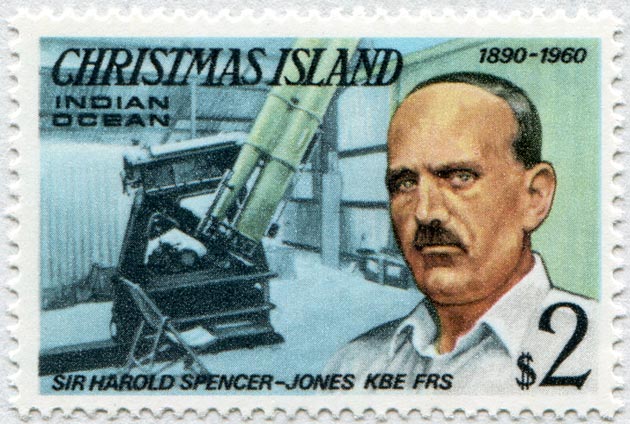
The Astrographic Telescope on Christmas Island. One of 16 stamps of famous visitors to Christmas Island issued in four tranches (of four) between 30 April 1977 & 1 September 1978. The highest value stamp in the series, it was issued as part of the second tranche on 22 February 1978. Designed by V. Whiteley Studios and printed by Harrison & Sons Ltd., London
Post war at Greenwich
Mothballed during the Second World War, the telescope was brought back into use at Greenwich in 1947/8 when it was employed for experimental work on photo-electric guiding for possible future use with the Transit Circle and supplying the Isaac Newton Telescope with fully automatic guiding capable of correcting atmospheric effects several times a second.
In March 1950, the instrument was restored to full working order, with the restoration of the gravity drive, the control pendulum of the 26-inch refractor being used in place of the original pendulum which had seriously deteriorated during 11 years of forced disuse. The 3-inch finder scope was also replaced; having at some time in the past developed a crack (see the annual report for 1951 for more details).
As the only one of the large refractors to have been brought back into use, it was used for observations of comets and the brighter minor planets, occultations and the testing of a camera constructed around a 5½-inch Ross aircraft reconnaissance lens.
The move to Herstmonceux and the fitting of proper dew caps
The telescope stayed at Greenwich until 1956/7 when it was moved to Herstmonceux and re-erected in dome D in August 1957. As the dome was not completed until January 1958, the telescope could not be brought into use until then. While the object glass (OG) was off, its colour curve was measured and found to be as follows
| Wavelength (A) | Focal length (mm) | |
| 4300 | 3438 | |
| 5000 | 3441 | |
| 6000 | 3449 | |
| 7000 | 3457 |
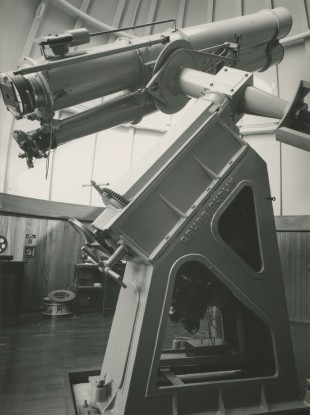
The Astrographic Telescope at Herstmonceux with the Markowitz Moon camera fitted at the breach end. Taken prior to 11 January 1961, the photo also shows the Astrographic's own plate carrier on the floor by the wall (left). Humphry Smith Photographic Archive
When originally installed at Greenwich, only the 10-inch OG of the guiding telescope of the Astrographic appears to have had a dew cap fitted. This was almost certainly because the dome had been designed for a much smaller instrument and was too small to allow one to be fitted to both lenses. At Herstmonceux, the dome was sufficiently spacious for new dew caps to be fitted to both OGs. When the telescope was moved to Herstmonceux, the gravity drive was also replaced by a synchronous motor.
The Markowitz Moon camera and the atomic second
When the notion of Ephemeris Time was adopted in the early 1950s based on the orbital motion of the Earth rather than on its rotation, William Markowitz of the US Naval Observatory devised a practical means for its determination by inventing the dual-rate Moon camera bearing his name.
The first camera was brought into use at the Naval Observatory in June 1952. Twenty cameras designed to be attached to either a visual or a photographic refractor of about 8 or more inches aperture and of moderate focal length, (ideally 80 to 240 inches) were used around the world during the International Geophysical Year (1 July 1957, to 31 December 1958), including at Herstmonceux, where the programme ran until 11 January 1961.
The data generated, allowed Markowitz and Louis Essen (at the National Physical Laboratory in London) to calibrate the new atomic clocks in terms of the Ephemeris second (Markowitz obituary). The number they determined, 9,192,631,770, became the fundamental frequency of caesium atomic clocks, and was adopted as the international definition of the second in 1967.
Although in the past, astronomers had tried to measure the position of the Moon using photographic techniques, they had failed on account of its motion relative to the stars, its size and its relative brightness. The Markowitz camera, was designed specifically to overcome these problems. Markowitz explained the principles of its operation as follows in his 1954 paper Photographic determination of the Moon's postion ... :
‘Precise guiding is needed on both stars and moon, and the telescope clock drive is not used. The synchronous motor and micrometer, shown at the left, drive the moving plate carriage at the sidereal rate. The moon's image is intercepted by a dark filter, of transmission factor 0.001, which is a plane-parallel glass plate I.8 mm thick. The motor and micrometer shown at the top tilt the filter during the exposure, thereby shifting the image of the moon. The rate of tilt is adjusted so as to hold the moon fixed relative to the stars.
Three settings are made on the camera when observing: for the sidereal rate corresponding to the moon's declination, for the moon's speed, and for the position angle of the axis of tilt. The computations and mechanical settings are easily made.
A light yellow filter having a hole at the center cuts out the blue rays of the stars. An electrical contact, shown at the top, is set to record on a chronograph the instant when the two filters are parallel. At this moment the filters produce no relative shift of the moon and stars. Hence, this instant defines the epoch of observation. The adjustment for timing, which is easily made by examining reflected images, remains fixed. If the camera is reversed 180° between exposures any error in timing is eliminated.
A light fixed to the camera-body generates a trail about 6 mm long during the exposure. This trail allows the plate to be oriented rapidly in the measuring engine and serves to check the orientation of the camera.’
The Herstmonceux camera (which was on loan from the U.S. Naval Observatory), was ‘used for some 10 days in each lunation’ and was swapped over with the telescope’s normal plate carrier ‘twice each month’.
Galatic structure, proper motions and comparative measurements with the Oxford object glass
An early programme with the Astrographic Telescope in its new home at Herstmonceux was the measurement of proper motions as part of a larger study on Galactic structure. This involved re-photographing the skies and comparing the new photographic plates with the historic ones of the Greenwich and Oxford astrographic zones. Because the accuracy of the proper motions would be limited by differences in the imaging of the Greenwich and Oxford objectives, it was arranged to borrow the Oxford object glass (OG) so that the differences in their imaging could be compared.
The Oxford OG was sent to Herstmonceux in 1961 and is believed to have remained at Herstmonceux ever since. It is currently on display in dome F.
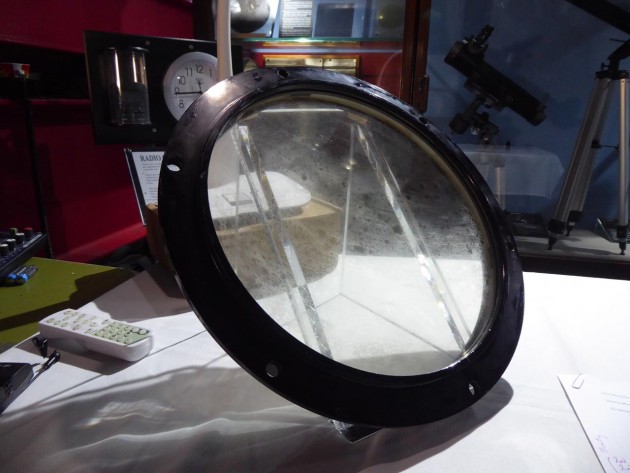
The Oxford Astrographic lens at Herstmonceux on 29 May 2019 on the centenary of the 1919 eclipse. The curved streaks on the glass appear to be on the inner surface(s) and are assumed to have arisen from residues when it was last cleaned (in 1961?)
Although the Greenwich and Oxford Astrographic Telescopes were made by Grubb to the same specification, they differed in two key respects: the accompanying guiding telescope and the design of the object glass. The Greenwich instrument, like that supplied to the Cape and some of the other five observatories, came with a 10-inch Grubb visual guiding telescope of the same focal length on a purpose made German Equatorial Mount. The Oxford instrument however was piggybacked onto an existing 12-inch Grubb Refractor which was used as the guiding telescope. This had a narrower field of view than the 10-inch grubb and had been installed at the Oxford Observatory in 1874. In 1923 the optics of the 12-inch Grubb were refigured (by Cooke, Troughton and Simms) and in 1961, the telescope having been deemed redundant, was acquired by Keele University. By then, the Astrographic telescope was no longer present. Seemingly dismounted at some point after 1936, the fate of the tube remains unknown despite an extensive search on the part of Keele during 2010. The object glass however was retained and (as mentioned above), was loaned by Oxford to the Royal Greenwich Observatory.
Although both OGs had both been briefly at Greenwich in 1919 prior to being taken to Liverpool for shipping to Madeira and onwards to sites in Principe and Brazil for observations of the 29 May 1919 solar eclipse, it was seemingly only when the Oxford OG arrived at Herstmonceux, that it was discovered that the Oxford and Greenwich lenses were of a different design. The Greenwich OG is conventional with the crown glass component in front. The Oxford OG has the flint in front, in the form of a negative meniscus, with front radius of curvature 65 inches. The crown component is nearly pIano-convex, its rear face having a radius of curvature of 750 inches.
Tests showed that the Oxford OG had an effective focal length that was 2.5 cm longer with the focal distance as measured from the flange of the cell that was 10.5 cm longer. An adaptor was made in the Observatory workshop to extend the Greenwich tube by this amount for use with the Oxford OG. Later research by O’hora (1988) found that the Cape Astrographic had an OG similar to the Greenwich one, whilst the Sydney and Melbourne telescopes had ones similar to that of Oxford.
According to the Reports of the Astronomer Royal, the Oxford OG was brought into use at Herstmonceux on 26 June 1961 and removed on 13 March 1963 when the Greenwich OG was replaced. Its squaring-on was altered on 9 April 1962 ‘to simulate as far as possible, the maladjustment affecting some of the original plates (See 1962 report and DHP Jones (1988) for further details).
The Franklin Adams wide-angle Star Camera
In the mid 1960s, the 6-inch Franklin Adams wide-angle Star Camera was mounted piggyback onto the Astrographic Refractor. It was used during the reporting year 1965/6 to search for new variables by comparing the developed plates using a technique known as ‘blink’ comparison. Still mounted on the Astrographic Telescope in 1985, its current whereabouts is unknown.
The new mounting of 1969
A new mounting was provided by Grubb Parsons in 1969. The old mounting is now in the care of the National Maritime Museum (Object ID: AST0931).
The Astrographic Refractor at Herstmonceux in 2011. Reproduced under the terms of a Creative Commons Attribution-NonCommercial-NoDerivs (CC BY-NC-ND) licence courtesy of Melanie Davies (see below)
Contemporary accounts
The Astrographic Telescope and its method of use were described in some detail by Christie in the introduction to the first volume of the Greenwich Section of the Astrographic Catalogue. The use to which the telescope was put each year, together with any alterations to it, were normally recorded in the annual reports.
Further Reading
The following four authors from the list below all worked with the Greenwich Astrographic Telescope: Turner, Davidson, Wayman and Jones.
Turner, H.H. The Great Star Map (London, 1912). Note: in this online copy, pages 156 & 157 appear at the start of the book.
Charles Rundle Davidson. Astronomical Photography, being chapter five from Photography as a scientific implement (a collective work by Davidson & others (New York: 1923)
Wayman, P. A. The Grubb Astrographic Telescopes, 1887-1896. Jones, D.H.P. The Greenwich and Oxford Astrographic Telescopes 1958–1987. Mapping the Sky: Past Heritage and Future Directions: Proceedings of the 133rd Symposium of the International Astronomical Union, held in Paris, France, 1-5 June 1987. Edited by Suzanne Debarbat. International Astronomical Union. Symposium no. 133, Kluwer Academic Publishers, Dordrecht.
Perryman, Michael. The making of History’s Greatest Star Map (Heidelberg: Springer, 2010)
Perryman, Michael. The History of Astrometry (2012)
Image Credits and licensing arrangements
| Second from top (left) | The plate carrier of the Astrographic Refractor, c.1900. Reproduced under the terms of a Creative Commons Attribution-NonCommercial (CC BY-NC) licence courtesy of whatsthatpicture. For link to original image click here | |
| Second from top (right) |
The Astrographic Refractor and the clock Dent 2017, c.1900. Reproduced under the terms of a Creative Commons Attribution-NonCommercial (CC BY-NC) licence courtesy of whatsthatpicture. For link to original image click here | |
| Bottom | The Astrographic Refractor at Herstmonceux in 2011. Reproduced under the terms of a Creative Commons Attribution-NonCommercial-NoDerivs (CC BY-NC-ND) licence courtesy of Melanie Davies. For link to original image click here |
© 2014 – 2025 Graham Dolan
Except where indicated, all text and images are the copyright of Graham Dolan
